

Atlantis: Timaeus and Critias. [ Introduction || The Dialogues || Cast of Characters ] Timaeus and Critias, two of Plato's dialogues, are the only existing written records which specifically refer to Atlantis.

The dialogues are conversations between Socrates, Hermocrates, Timeaus, and Critias. Apparently in response to a prior talk by Socrates about ideal societies, Timeaus and Critias agree to entertain Socrates with a tale that is "not a fiction but a true story. " Hinduism - Puranas. Sacred-texts home Journal Articles: Hinduism OCRT: Hinduism Buy CD-ROM Buy books about Hinduism Vedas Upanishads Puranas Other Primary Texts Epics Mahabharata Ramayana Bhagavad Gita Vedanta Later texts Modern books The Vedas There are four Vedas, the Rig Veda, Sama Veda, Yajur Veda and Atharva Veda.
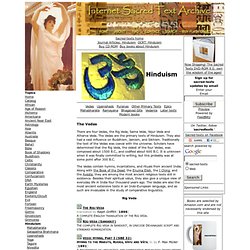
The Vedas are the primary texts of Hinduism. They also had a vast influence on Buddhism, Jainism, and Sikhism. Condon Report, Sec 5, Chapter 1: UFOs in History. Chapter 1.

Enoch & the Nephilim - Part III. Enoch & the Nephilim Part III The Evidence Mounts "More and more we are finding that mythology in general though greatly contorted very often has some historic base.

And the interesting thing is that one myth which occurs over and over again in many parts of the world is that somewhere a long time ago supernatural beings had sexual intercourse with natural women and produced a special breed of people. " -Francis A. Schaeffer. Kebra Nagast. The Kebra Nagast (var. Kebra Negast, Ge'ez ክብረ ነገሥት, kəbrä nägäst), or The Glory of the Kings, is a 14th-century[1] account written in Ge'ez of the origins of the Solomonic line of the Emperors of Ethiopia. The text, in its existing form, is at least 700 years old and is considered by many Ethiopian Christians and Rastafarians to be an inspired and a reliable work. Library of Ashurbanipal. The Royal Library of Ashurbanipal, named after Ashurbanipal, the last great king of the Neo-Assyrian Empire, is a collection of thousands of clay tablets and fragments containing texts of all kinds from the 7th century BC.

Among its holdings was the famous Epic of Gilgamesh. Due to the sloppy handling of the original material much of the library is irreparably jumbled, making it impossible for scholars to discern and reconstruct many of the original texts, although some have survived intact. The materials were found in the archaeological site of Kouyunjik (ancient Nineveh, capital of Assyria) in northern Mesopotamia. The site is in modern day Iraq.[2][3] Old Persian and Armenian traditions indicate that Alexander the Great, upon seeing the great library of Ashurbanipal at Nineveh, was inspired to create his own library.
Discovery[edit] Contents[edit] Ashurbanipal was not above using war booty as a means of stocking his library. Epic of Gilgamesh. ENUMA ELISH. Sacred-Texts Ancient Near East.
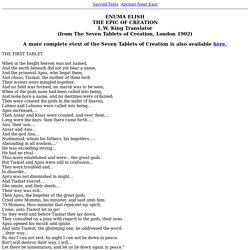
Mahabharata. Samarangana Sutradhara. Samarangana Sutradhara is an encyclopedic work on classical Indian architecture (Vastu Shastra) written by Paramara King Bhoja of Dhar (1000–1055 AD).
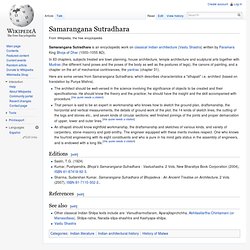
In 83 chapters, subjects treated are town planning, house architecture, temple architecture and sculptural arts together with Mudras (the different hand poses and the poses of the body as well as the postures of legs), the canons of painting, and a chapter on the art of mechanical contrivances, the yantras (chapter 31). Here are some verses from Samarangana Sutradhara, which describes characteristics a "sthapati" i.e. architect (based on translation by Punya Mishra). Vaimanika Shastra. Title page of the English translation of Vyamanika Shastra published in 1973 The Vaimānika Śāstra (वैमानिक शास्त्र, lit.
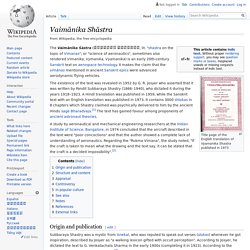
"shastra on the topic of Vimanas"; or "science of aeronautics", sometimes also rendered Vimanika, Vymanika, Vyamanika) is an early 20th-century Sanskrit text on aerospace technology. It makes the claim that the vimānas mentioned in ancient Sanskrit epics were advanced aerodynamic flying vehicles. Vimana. Vimāna is a word with several meanings ranging from temple or palace to mythological flying palaces described in Sanskrit epics.
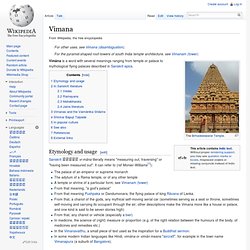
Etymology and usage[edit] Sanskrit विमान vi-māna literally means "measuring out, traversing" or "having been measured out". It can refer to (ref Monier-Williams[1]): Vimanas. The workings of the mercury vortex technology David hatcher Childress has explained a bit further, the theory of the mercury vortex technology.
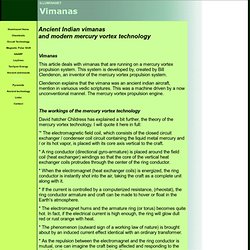
I will quote it here in full: Popol Vuh. The oldest surviving written account of Popol Vuh (ms c.1701 by Francisco Ximénez, O.P.) Popol Vuh (Popol Wuj [poˈpol wuχ] in modern K'iche') is a corpus of mytho-historical narratives of the Post Classic K'iche' kingdom in Guatemala's western highlands. Chilam Balam. Copy of the Book of Chilam Balam of Ixil in the National Museum of Anthropology, Mexico The so-called Books of Chilam Balam[pronunciation?] Are handwritten, chiefly 17th and 18th-centuries Maya miscellanies, named after the small Yucatec towns where they were originally kept, and preserving important traditional knowledge in which indigenous Maya and early Spanish traditions have coalesced. Written in the Yucatec Maya language and using the Latin alphabet, the manuscripts are attributed to a legendary author called Chilam Balam, a chilam being a priest who gives prophecies and balam a common surname meaning 'jaguar'.
Some of the texts actually contain prophecies about the coming of the Spaniards to Yucatán while mentioning a chilam Balam as their first author.[1] Nine Books of Chilam Balam are known,[2] most importantly those from Chumayel, Mani, and Tizimin,[3] but more have existed. Contents[edit] 1. 2. 3. 4. 5. 6. Scholarship[edit] Notes[edit] Zoroastrianism. Religion ascribed to the teachings of Zoroaster With possible roots dating back to the Second Millennium BCE, Zoroastrianism enters written history in the 5th century BCE.[13] It served as the state religion of the ancient Iranian empires for more than a millennium, from around 600 BCE to 650 CE, but declined from the 7th century CE onwards following the Muslim conquest of Persia of 633–654 and subsequent persecution of the Zoroastrian people.
Recent estimates place the current number of Zoroastrians at around 110,000–120,000[15] at most, with the majority living in India, Iran, and North America; their number has been thought to be declining.[16][17] VENDIDAD: Table of Contents. AVESTA: Vendidad. Akkadian language. The mutual influence between Sumerian and Akkadian had led scholars to describe the languages as a sprachbund.[3] Akkadian proper names were first attested in Sumerian texts from ca. the late 29th century BC.[4] From the second half of the third millennium BC (ca. 2500 BC), texts fully written in Akkadian begin to appear.